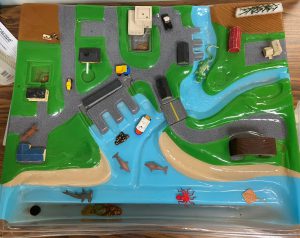(This blog post is third in a series recounting a summer internship opportunity for the author. Collaborating with Martin County 4-H Youth Development and Florida Sea Grant extension agents, this account provides a unique perspective on the career development of young adults into UF/IFAS Extension professionals.)
Where Does the Water Go?
The movie “Finding Nemo” teaches a noteworthy lesson: all drains lead to the ocean. This week in the Junior Water Academy, we taught the 4-H members about watersheds and stormwater runoff. Building from last week’s lesson, precipitation in the form of rain can either evaporate or seep down into the Earth’s natural land into an underground aquifer. Stormwater can also run off from hard surfaces in our watershed into drains and carry harmful pollutants down to the ocean.

The Enviroscape®
The Enviroscape® 3-D watershed model is a perfect interactive demonstration to help children and adults understand how all the materials we generate and use (such as sewage waste, litter, pesticides, herbicides, fertilizer, etc.) contribute to the lasting effects of our oceans’ threats and challenges. The children easily visualized how polluted water ultimately travels through bodies of water. They saw the effect of runoff on sea creatures nearby. Three dimensional models are tangible tools to help youth grasp these concepts.

To connect back to the 4-Hs and evaluate the impact of the activities, this week’s lesson was organized into the following categories:
Hands: Beginning with a fun ice breaker, the kids demonstrated teamwork by trying to keep a water balloon on a bed sheet or blanket without letting it pop.
Head and Health: The Junior Water Cadets learned about watersheds through the Enviroscape® demonstration and recognized that stormwater runoff, when polluted, is not completely safe for the environment and ecosystems.
Heart: The stormwater scavenger hunt activity at the end of the lesson taught youth about which aspects of our environment are ultimately good or bad for the ocean. Or as some decided, the issues are complicated.
From my perspective, 4-H youth development is all about learning progression. As Malcom X said: “Education is our passport to the future, for tomorrow belongs to the people who prepare for it today”.
by Madison Borman; University of Florida CALS Intern
 0
0
